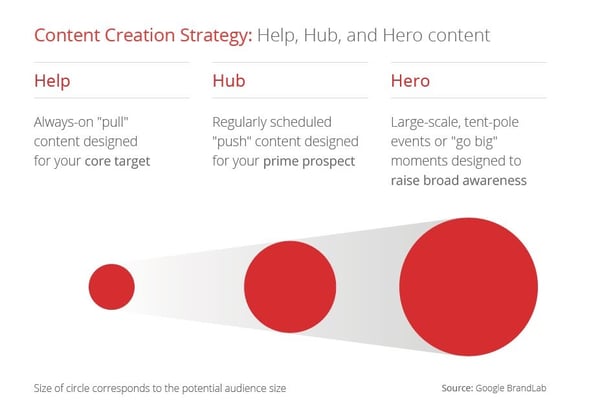August 1, 2025
 by Yashwathy Marudhachalam / August 1, 2025
by Yashwathy Marudhachalam / August 1, 2025

Over the last few years, social media marketing content has evolved from an optional add-on to a must-have channel for brands of all sizes and across every industry. Whether you're a scrappy startup or a global enterprise, different types of social content are among the most cost-effective ways to build trust, visibility, and community.
That accessibility is a huge advantage. Social content is often free to post, fast to produce, and tailored for the platforms your audience uses daily. But don't let its low barrier to entry fool you. Some of the world's most iconic brands, from Taco Bell and Starbucks to J.Crew and Calvin Klein, run incredible Instagram marketing campaigns that blend storytelling, seasonal relevance, and sharp visuals to drive real revenue, especially during high-conversion periods like the holidays.
These aren't just vibes and vanity metrics. They're data-backed strategies with clear ROI, and your brand can tap into the same playbook. So what's the secret sauce? What kinds of social content are best for promoting your business? You can't achieve social media marketing success without the right social media marketing software, which helps brands plan, publish, and measure content effectively.
Let's break it down.
To drive meaningful engagement, your social media marketing content should align with the buyer’s journey and your strategic objective, whether to educate, entertain, or convert. Here’s how to map the right content to each stage of the funnel.
| Funnel stage | Objective | Content format | Why it works |
| Awareness | Entertain | Memes, GIFs, Reels, Polls, Trending audio clips | Instantly attention-grabbing, highly shareable, light engagement barrier |
| Inspire | Inspirational quotes, Emotional videos, UGC (user-generated content) | Taps into emotions; increases brand affinity and social sharing | |
| Educate | Blog snippets, Infographics, Quizzes | Delivers digestible info that builds interest without overwhelming | |
| Consideration | Guide | How-to blogs, Webinars, Podcasts, Instagram carousels | Demonstrates thought leadership and solution expertise |
| Answer | Q&A reels, Infographics, AMA sessions | Directly addresses audience pain points, builds trust | |
| Entertain + educate | Story Highlights, Interactive checklists, Carousels | Balances engagement with valuable insight to maintain audience attention | |
| Decision | Convince |
Case studies, Demos, Testimonials, Influencer marketing, Feature walkthroughs |
Shows real success stories and product capabilities; reassures hesitant buyers |
| Capture leads | Shows real success stories and product capabilities; reassures hesitant buyers | High-value, long-form content exchanges access for leads | |
| Showcase | Product videos, Customer reviews, Feature explainer videos | Highlights value propositions clearly and visually |
The bottom line is to diversify your content by type, platform, and purpose. You’ve got a ton of options, each with its own strategic niche. For inspiration, check out these CMO-recommended content tactics for Q4.
When most marketers think of "social media," they default to Facebook or Instagram. While those platforms are still heavyweights, today's landscape is broader, faster-moving, and far more segmented.
To succeed in modern social media marketing, you need to go beyond "posting everywhere" and instead choose platforms based on your:
Here's a strategic breakdown of today's top social platforms, including what works where, and how to align your content formats accordingly.
This one’s still the big gorilla, even after so many years. And it’s super versatile; you can post all kinds of content. Facebook posts are highly versatile and work well for various content formats, especially when tailored to how users consume media on the platform. It's particularly effective for:
Video tends to earn the highest reach among these, followed by images, links, and plain text. To boost performance, always pair your visual content with compelling captions, CTAs, and links that drive users deeper into your funnel.
Use for: Multi-format campaigns, retargeting audiences, community groups, and mid-funnel content distribution.
Tool Tip: Explore top-rated Facebook Marketing Software.
Instagram remains a hub for visual-first content, but it’s no longer just about pretty photos. Quality content with the right hashtags can keep an Instagram feed post engaged for days. It’s a visual platform, which makes it great for advertising. You don’t need to be a photoshop expert to get started. A bank of high-resolution product images or striking, unique stock photos and a design tool with ready-made Instagram post templates will go a long way.
Product teasers and other promotions with thematic seasonal imagery do well. Don’t limit yourself to still images, though; you can also leverage the power of Instagram videos via your posts, story, live videos, or IGTV (depending on the scope of the video). Each option has unique length requirements.
Today, it supports a range of high-performing formats:
Trend Alert: Instagram’s algorithm now prioritizes Reels and high-retention video content, so go beyond static visuals and start leaning into video.
Use for: Awareness and engagement campaigns, influencer activations, brand-building, and shoppable posts.
While Twitter (now X) has gone through big changes, it remains a powerful channel for real-time marketing, commentary, and niche thought leadership – especially if your brand thrives in fast-moving conversations. Unlike other platforms, Twitter feeds move fast and have a brief half-life.
This means you could even tweet the same thing at different times and days to reach a new audience. Photos and videos have the best engagement. The extremely short format is also perfect for link sharing. Find industry-adjacent content and share it with your followers to establish your status as an in-the-know resource.
Hashtag marketing is another relevant strategy born with Twitter and since expanded to other social sites.
Break down your content into a narrative. Start with a strong hook, then layer value:
"Social media isn't just about going viral. Here's how we use five content pillars to drive consistent B2B leads — thread"
Use trending or niche hashtags wisely (1–2 max), and follow daily trend cycles. Tools like TweetDeck or X Pro help monitor keywords in real time.
Turn blog posts, case studies, or webinars into 3–5 tweet insights with links to gated content or landing pages.
Make your profile work as a landing page by pinning a tweet that leads to a resource, newsletter, or offer.
Use Twitter/X for industry commentary, real-time event engagement, community building, and driving top-of-funnel traffic through timely, conversational content.
As a professional-focused network, LinkedIn gives better traction to B2B social content, helping companies connect with other business owners more effectively than on consumer-focused platforms like Instagram.
Use for: Lead nurturing, B2B awareness, employee advocacy, and subject matter authority.
Many people forget that YouTube is not only a social platform, but the second-most trafficked site on the internet — with over 42.8 billion monthly visits in June 2025. Only Google had more. If you’ve got a minute, check out this mesmerizing time-lapse from FastCompany that shows YouTube’s rise to dominance.
Video marketing statistics from more recent years continue to show this trend, with 89% of businesses now using video as a marketing tool. You can seize this opportunity by curating an active company YouTube channel. Try branded customer testimonials (great for building your credibility), demos, tutorials, and explainers that show your product or service in action. Not all brand content needs to center on your business, though. Interviews with thought leaders in your space can be very compelling top-of-funnel content.
Google (YouTube’s parent company) recommends a three-tiered strategy with a mix of “Hero,” “Hub,” and “Help” branded video content.

This breakdown will raise awareness, nurture prospects, and delight your core audience. Host the videos on your channel, but don’t forget that you can also embed YouTube videos on your company website (as 61 of the top 100 brands, like Coca-Cola and Toyota).
Finally, engagement campaigns can really set your campaign apart by opening a dialogue with your audience that humanizes your brand. I always think about the "Mano a Mano in El Baño" campaign that pitted Fabio against “Old Spice Guy” Isaiah Mustafa in a series of funny video shorts where they engaged viewers directly and competed for the right to be Old Spice’s official spokesperson. Old Spice said the Fabio campaign hit high marks for views, comments, shares, and followers.
Use for: Mid-to-bottom funnel education, brand trust-building, and traffic-driving content that lives beyond the scroll.
The lifespan of social content formats varies wildly by platform. Pinterest pins tend to last longer than social content on any of the other major social media sites; high-quality pins can continue to garner repins and engagement for a year or more. Pinterest behaves more like a hybrid between a search engine and a vision board.

Like Instagram, it’s a visual platform. Purchase intention is also much higher than in many other channels. Due to the longevity of the content, however, it’s less optimal for timely updates or short-term promotions. The platform skews female, which is something to consider in how you position your Pinterest strategy.
It’s particularly strong for:
Use for: Bottom-funnel conversion, niche visual content, long-tail engagement.
Snapchat may not get as much industry buzz as TikTok or Instagram. However, it’s still a powerhouse for Gen Z engagement, especially regarding direct interaction, playful branding, and mobile-first storytelling.
If your target audience includes teens to early 20s, this platform gives you a direct line into how they communicate and consume content.
Snapchat’s “story” format (later adapted by Instagram and Facebook) is perfect for short how-to videos that divide steps naturally into a few brief snaps. You could also encourage 1:1 participation through games, interactive projects, or user-generated content.
Use Snapchat for: Product reveals with interactive filters, limited-time offers tailored to Gen Z, authentic brand storytelling through creator takeovers and day-in-the-life snippets, and early access or VIP campaigns that feel intentionally personal and unpolished.
Since you’re creating marketing content, the end goal for your business is already clear. You’re here to generate awareness, nurture leads, and (eventually) inspire conversion.
But what are you trying to do for your audience? Too often, brands focus only on what they want to say, not what users want to experience. However, the most impactful social media marketing content is purpose-driven. It earns attention by delivering real value: education, entertainment, answers, or inspiration. In some cases, that even overlaps with the types of social commerce you use to connect content directly to sales.
Below, we summarize seven strategic purposes your social media marketing content should serve, each with clear content types, platform fits, and tactical recommendations.
What it does: Provides step-by-step help or instruction
Why it matters: Builds trust, positions your brand as a resource
Best for: Top-to-mid funnel content, onboarding, nurturing
Content formats:
Customers and clients come to you armed with questions. It pays to have ready-made content with the answers. Use short Q&A blog posts or infographics to answer common questions relative to your topic.
What it does: Provides direct answers to common questions or concerns
Why it matters: Builds trust, supports buying decisions
Best for: Mid-funnel engagement, customer support, brand transparency
Content formats:
The common example would be the “why” article. These informative pieces tell the story of why something is the way it is, and tend to be full of research and information that branches out into background and nuances within the subject. Design this type of content around a topic in which your audience has a vested interest/curiosity.
What it does: Explains the “why” or provides in-depth context
Why it matters: Establishes expertise, ideal for B2B or complex products
Best for: Nurturing, thought leadership, SEO cross-promotion
Content formats:
An alert is a heads up. Let your social audience know about a branded/sponsored event or a time-bound opportunity. You’ll likely want to include a link to more info (on your website) and a place to sign up (perhaps a stellar landing page optimized for maximum conversions). It could also take the form of a company newsflash or press release with information your audience would want brought to their attention in a quick update.
What it does: Notifies your audience of something time-sensitive
Why it matters: Drives quick action, builds awareness of offers or events
Best for: Campaign launches, webinars, sales, product releases
Content formats:
5. Entertain: Make your audience feel something
Social media is an excellent medium for finding the sense of humor in your brand voice. Make your target audience laugh. Content could include fun connections between unlike things, self-aware humor, and an opportunistic (but harmless) joke about common experiences this time of year. Don’t belabor it with long content — humor is quick.
What it does: Sparks emotion, laughter, or joy
Why it matters: Drives virality, increases reach through shares
Best for: Awareness-stage content, brand-building
Content formats:
Not all content needs to be your own! In fact, much of it probably shouldn’t. It’s easier to fill a content calendar and stay active if you can supplement it with interesting or useful industry articles that aren’t promoting direct competitors. Outside thought leadership can build your audience by connecting your brand with one they’ve heard of and trust already.
What it does: Highlights voices beyond your brand
Why it matters: Builds credibility, expands reach, and eases content load
Best for: Community-building, third-party validation, and driving social media engagement.
Content formats:
A cornerstone of content marketing is SEO. Find the keywords your audience is searching for, and write the content that they’re trying to find. It should be easily linkable content, since backlinks can boost SERP rankings a ton.
As interest in (and traffic to) the content grows, so will its search position. SEO keyword tracking software can help you create content with text that’s optimal and visible for web crawlers (blogs, pillar pages, articles, listicles).
What it does: Surfaces keyword-driven content on social
Why it matters: Supports organic traffic growth and repurposing
Best for: SEO amplification, evergreen discoverability
Content formats:
Got more questions? Get the answers here!
Short-form videos (Reels, TikToks, YouTube Shorts), interactive polls, carousels, and memes drive the highest social media engagement. These social content formats are quick to consume, shareable, and align with platform algorithms prioritizing interaction.
There’s no universal rule, but consistency matters more than volume. For example, 3–5 posts per week on Instagram, 1–2 LinkedIn updates weekly for B2B social content, and daily tweets or threads on Twitter/X can maintain visibility without overwhelming your audience.
B2B social content often focuses on thought leadership, case studies, and long-form formats that build trust and authority. B2C, on the other hand, thrives on emotional storytelling, user-generated content, and fast-moving trends that encourage quick shares.
Success depends on your SMM content strategy. Common metrics include engagement rate (likes, shares, comments), reach, conversions, and leads generated. Aligning KPIs with your goals—awareness, consideration, or sales—is key to proving ROI.
Use free posts (like infographics, memes, or short tips) to maximize reach and awareness. Save gated content (like eBooks, whitepapers, and webinars) for when you want to capture leads in the consideration or decision stage of your funnel.
Short-form videos, carousels, memes, and user-generated posts are the most effective social media marketing content for driving engagement.
Run hashtag campaigns, create share-worthy challenges, or highlight customer stories to inspire participation. Reposting UGC not only reduces your content workload but also builds authenticity and strengthens social media engagement.
Emotional content sparks feelings—whether humor, inspiration, or relatability—while interactive content invites action through polls, quizzes, or challenges. Both play an essential role in boosting social media marketing content performance across platforms.
When it comes down to it, mixing your content is the best way to reach a broad audience. You’ll want content that fits up and down the funnel, appeals to each of your marketing personas, and is optimized for a variety of social platforms. But don’t mix and match at random; purposeful choices should reflect your brand and audience.
For example, B2B is more likely to get leverage from case studies, eBooks, and whitepapers, but B2C thrives on interactive content, videos, humor, and short-form content that’s driven by an emotional CTA.
There will be differences even within your individual market. If you’re a SaaS, how-to webinars and demos will be in demand, whereas a hiking accessories company may get more mileage from user-generated images and inspirational testimonials.
Follow the data and keep an eye on what’s trending on competitor social accounts. These channels are always changing. The best type of social media marketing content for your brand may turn out to be the next one, so keep testing and refining your SMM content strategy.
Check out a comprehensive social media marketing guide packed with expert strategies and resources to level up your content game.
This article was originally published in 2020. It has been updated with new information.
Yashwathy is a Content Marketing Intern at G2, with a Master's in Marketing and Brand Management. She loves crafting stories and polishing content to make it shine. Outside of work, she's a creative soul who's passionate about the gym, traveling, and discovering new cafes. When she's not working, you'll probably find her drawing, exploring new places, or breaking a sweat at the gym.
YouTube has made content creation and sharing simpler.
 by Sagar Joshi
by Sagar Joshi
Instagram isn’t the new cool kid on the market anymore. Arguably, it’s more of an eternal...
 by Sagar Joshi
by Sagar Joshi
Today, video content is driving the internet.
 by Harpreet Munjal
by Harpreet Munjal
YouTube has made content creation and sharing simpler.
 by Sagar Joshi
by Sagar Joshi
Instagram isn’t the new cool kid on the market anymore. Arguably, it’s more of an eternal...
 by Sagar Joshi
by Sagar Joshi


